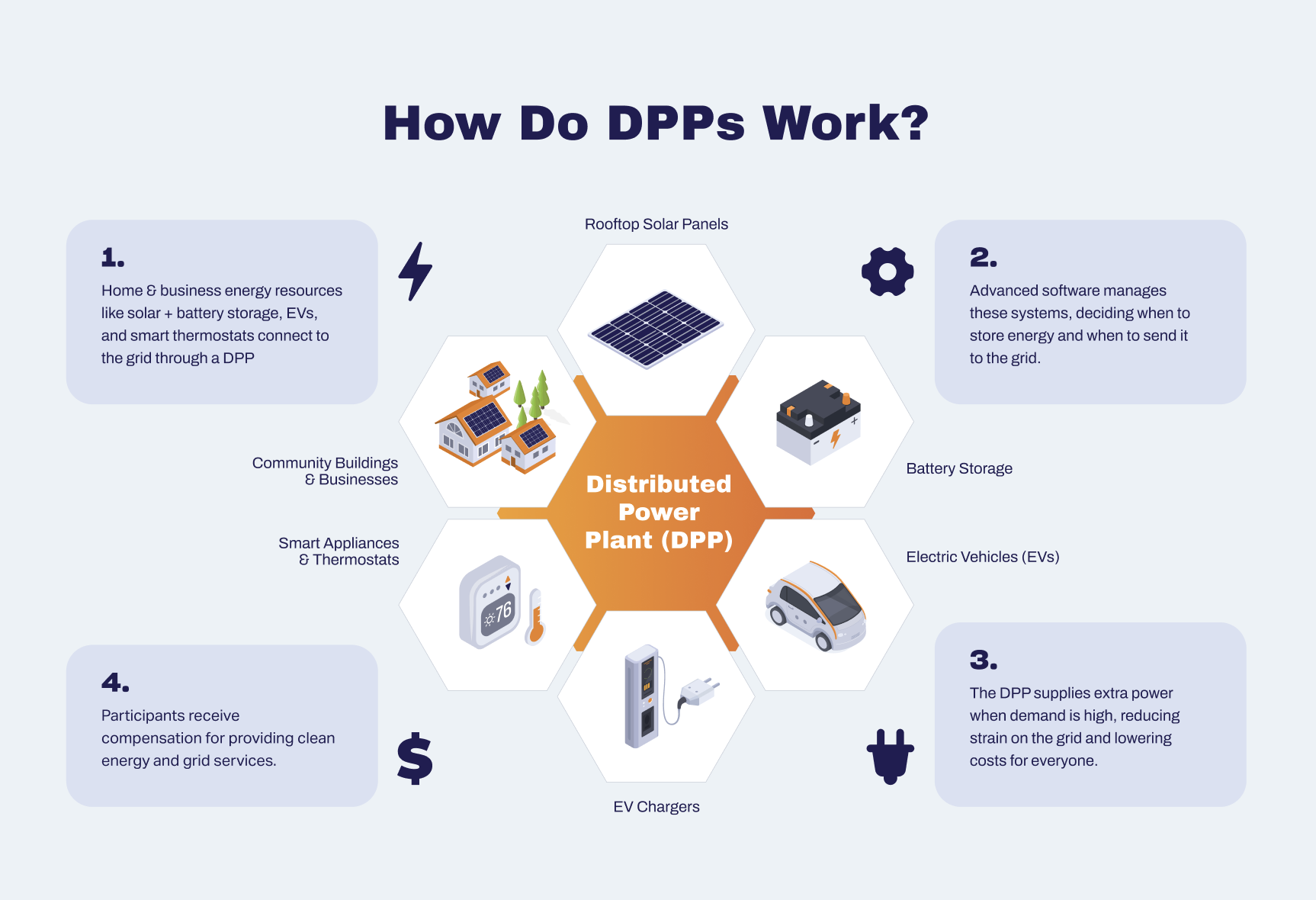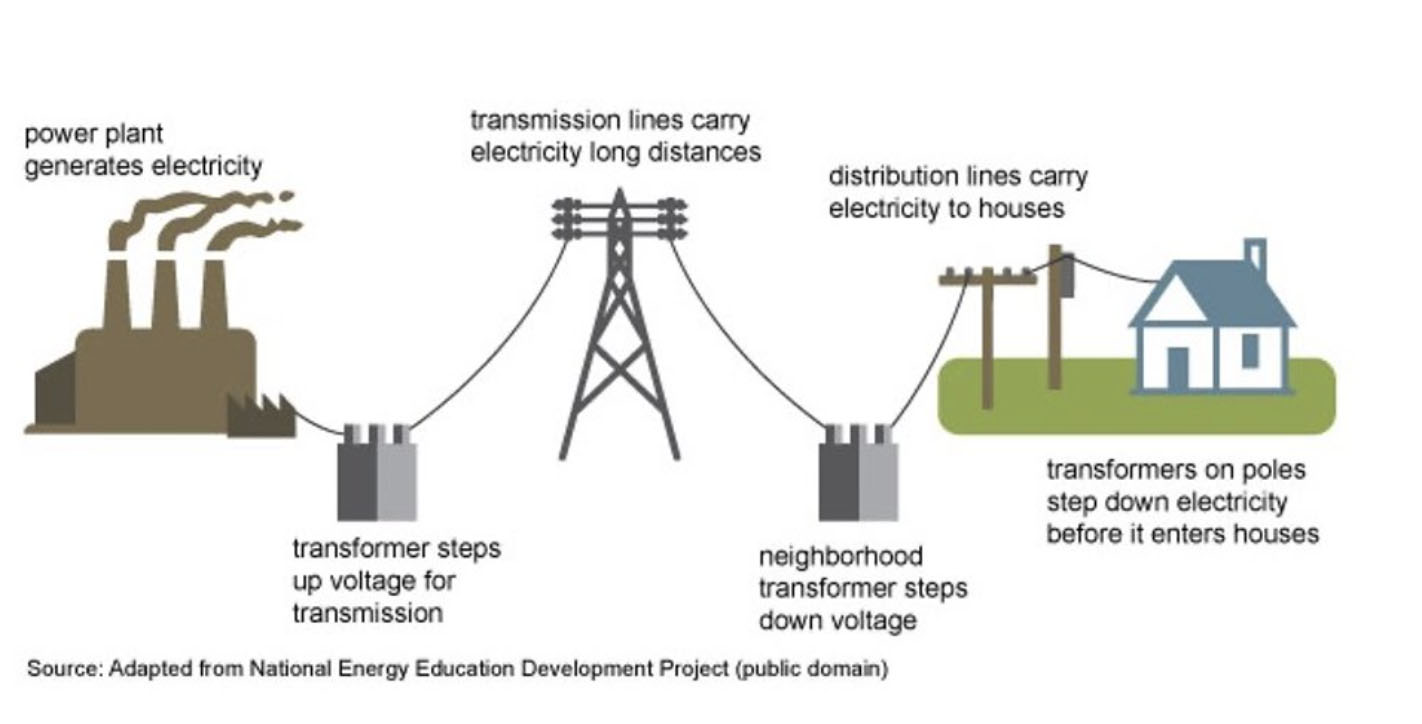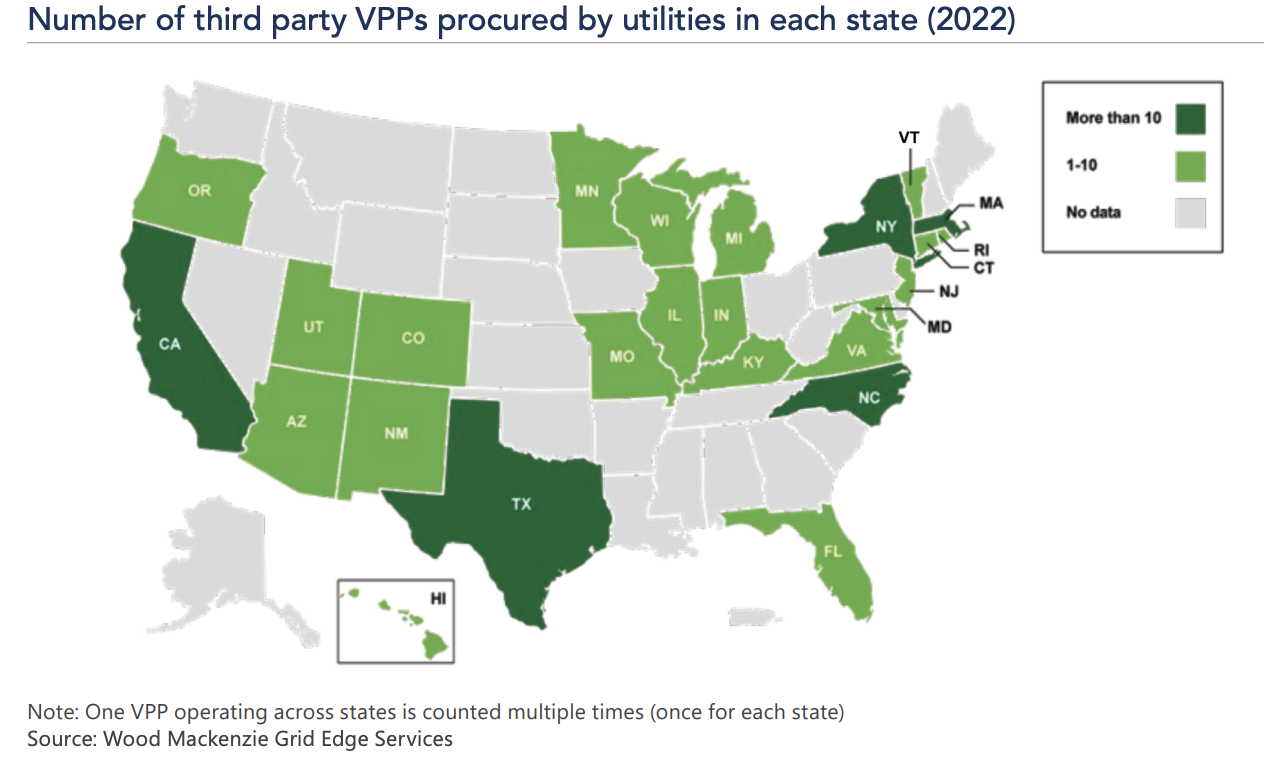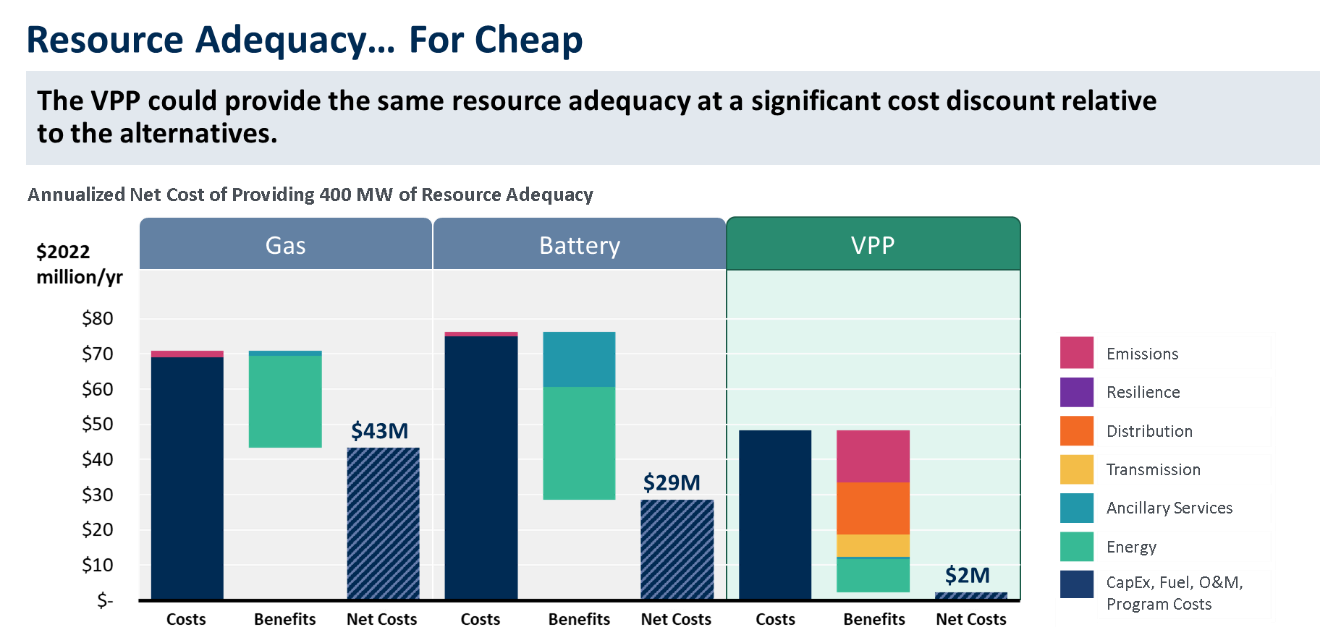Rooftop solar Distributed Power Plants: A better way to generate electricity
- Factsheet

The solar array on your home is just one system. It lowers your energy bills. And, if you have battery back-up, you feel safe knowing your lights can stay on if the power goes out.
Your solar array can do so much more. It can sync with other systems to provide a meaningful amount of electricity when our utility grid needs it the most. This lowers costs for everyone and makes our electric service more reliable.
Connecting a large amount of solar and battery systems together is called a Distributed Power Plant (DPP for short. It’s also called a Virtual Power Plant). You can think of this as a power plant that is in many places at once. Below we’ll explain why they’re needed, how they work, and action you can take to bring them to your community.
Current utility model is expensive, wasteful

To understand how DPPs work and their benefits, it’s first helpful to understand the way our current electricity distribution system works. To keep our lights on, refrigerators running, and electric toothbrushes powered, utilities must make sure the supply of electricity is greater than the demand. But, too much supply and they end up wasting money by buying unneeded electricity. To make things more complicated, demand for electricity changes constantly. Demand is typically higher during the day and lower at night. It’s higher during the week and lower on the weekends.
So, how do utilities meet this demand? Large, centralized power plants generate electricity. This electricity often needs to travel long distances to power our homes and businesses. Utilities also need to vary how much electricity they generate. At times of highest demand, they’ll buy power from power plants that only turn on when needed. These plants are called “peaker plants.”
The electricity from peaker plants is expensive because these plants don’t run all the time. Utilities pass the costs of running these peaker plants onto us in the form of higher bills. Maintaining this system is expensive. It’s also prone to disruption from storms and other natural disasters. We all pay the costs to maintain this system.
There’s another cost to this system. It favors monopoly utilities. When our current utility system developed, utilities were given monopolies over certain geographic territories. The thought was that this would be more efficient. This did make some sense. It wouldn’t be profitable for multiple companies to lay utility poles and wires in the same city, all connected to different power plants.
Unfortunately, over time, these monopoly utilities have grown immensely powerful, financially and politically. They use their monopoly to block competitors, like rooftop solar.
Why DPPs are a better way
Think of our current system of electricity distribution like sending a piece of fruit through the mail. The sender gives it to a mail carrier who takes it to a distribution center. It’s then sent out to another distribution close to where you live. Another mail carrier picks it up and delivers it to your home. If it gets there too soon, it won’t be ripe and will just sit there. If arrives too late, you’ve got spoiled fruit on your hands.
Wouldn’t it be easier just to pick a piece of fruit from your neighbors’ tree? That’s what distributed power plants are like.
DPPs work by putting together the electricity generated from rooftop solar systems with the storage capacity offered by distributed batteries. Grid operators can use the generated and stored electricity from participating solar and battery systems. This helps to prevent power outages, and turning on expensive and polluting peaker power plants. In return, solar owners earn compensation for the use of their investment.
This is how DPPs can create the equivalent of a large power plant to supply power to the grid when it is most needed and most expensive. These generation and storage resources are close to where the demand comes from. This saves the need for additional expensive electric grid infrastructure. This lowers utility costs for everyone!
The value of DPPs will grow in the coming years. This is because electricity demand is expected to increase. This is happening as more of us are switching to electric heating and cooling, as well as driving electric vehicles.
How DPPs work from a rooftop solar owner’s view
DPPs sound great, right? So how do solar owners participate? You can sign up to connect your solar-charged batteries to computer software. Your utility or a third-party company maintains this set up. By participating, you agree to have your batteries partially discharged to the grid at needed times. In exchange, you receive fair compensation for the power you share with your neighbors via the electric grid. You’d keep some of the energy in your batteries at all times so you can still use them if the power goes out.
Where are DPPs available?
DPPs aren’t available everywhere, yet. Small-scale DPP projects are underway now in twenty-five states (see map below). Several states, including Maryland and Colorado, are now setting up DPP programs (see here for examples DPP programs around the country).

How much can we save with DPPs?
- According to a 2023 study by the Brattle Group, a DPP costs roughly 40–60% less than alternative options to provide power. An estimated 60 GW of DPP deployment would save ratepayers $15–$35 billion over the ensuing decade. 60 GW is enough energy to provide power to 7.5 million homes. It would provide more than $20 billion in other societal benefits. These benefits include reduced pollution and more reliable energy service.
- A 2024 study projects that DPPs could save California consumers more than a half-billion dollars per year. DPPs could supply more than 15% of peak demand (5x the existing capability) by 2035. In the summer of 2023, Sunrun’s Peak Power Rewards distributed power plant program delivered up to 32 MW megawatts of power during evening peak hours. This was thanks to the participation of 8,500 customers and their batteries.
- The U.S. Department of Energy’s “Virtual Liftoff” report estimates that tripling the current scale of DPPs by 2030 could save ratepayers more than $10 billion in annual grid costs.

Making DPPs available to everyone
Everyone should be able to benefit from distributed solar energy. That’s why Solar United Neighbors is launching a national campaign to educate consumers and decision makers about the value of DPPs, and why we’re advocating that states and utilities launch statewide DPPs programs.
Our goal is to scale DPPs. We want to move from pilot project phases to large scale programs in every state. This is why we’ve developed DPP model policies and supporting state legislative language. Our model policy creates consumer-friendly, competitive and equitable DPP programs that fairly compensate solar owners for the power they share with the grid.
Review our DPP resources
Take Action
If you are a rooftop solar owner with a battery (or thinking of connecting a battery), consider participating in a DPP program if you live in a state and utility territory that offers one. If a DPP program isn’t available where you live, please contact your state legislators. Tell them that you want DPPs to be an option for solar owners.
For more information on SUN’s DPP campaign, request a presentation to your group, and how you can get involved, contact advocacy@solarunitedneighbors.org.
Examples of DPP programs
Arizona
Arizona Public Service Co.’s (APS) Bring Your Own Device (BYOD) program was approved in March 2025 to compensate customers for enrolling battery storage to help the utility meet peak energy demand needs during the hot summer months. Customers who participate in the BYOD Program will be compensated with an annual $110/kW capacity payment based on the seasonal average capacity of energy exported to the electric grid from their battery system. The utility would typically only use the additional generation when market rates would otherwise be much higher than the $110/kW rate, thus saving all ratepayers money.
Massachusetts
National Grid’s ConnectedSolutions Program, which operates in Massachusetts and other New England states, compensates customers for allowing their home batteries to contribute stored energy to the grid during times of peak demand, helping to lower overall grid strain while also providing financial incentives to participants. Participants average around $1,500 in annual incentives for connecting their home batteries to the system.
California
The California Energy Commission (CEC) Demand Side Grid Support (DSGS) Program is part of California’s Strategic Reliability Reserve, a suite of programs to alleviate tight energy supplies on the grid caused by heatwaves, wildfires, and other ongoing impacts of climate change. DSGS offers incentives to electric customers that provide load reduction and backup generation to support the state’s electrical grid during extreme events from May to October, reducing the risk of rotating power outages. The DSGS Program is open to eligible DSGS providers and participants and has three incentive structure options to choose from.
Customers of Pacific Gas & Electric, San Diego Gas & Electric, and Southern California Edison can also participate in the California Public Utility Commission’s Emergency Load Reduction Program, which offers incentives to customers at times of peak power demand. (See here for an evaluation of the state of grid services/demand response efforts in CA)
Vermont
Green Mountain Power’s (GWP) “Bring Your Own Device” (BYOD) program offers customers up-front payments to offset the cost of purchasing their own battery storage system from any installer. The BYOD program is structured as a per-kWh payment, where customers receive $850 per kW for storage enrolled for a three-hour discharge, $950 per kW for four-hour discharge, and an additional $100 per kW for storage deployed in areas of high congestion “where extra storage will help the grid most.” In 2020, state regulators converted GMP’s BYOD pilot into a permanent incentive program, available to five hundred customers per year with projects of up to 5 MW of capacity.
Utah
Rocky Mountain Power’s WattSmart Battery Program offers incentives to homeowners who install batteries paired with solar power, allowing the utility to draw stored energy to support the grid during peak demand. Participants receive upfront payments and annual bill credits based on their battery’s power output.
Colorado
Xcel Energy’s BatteryConnect Program provides incentives for customers who install energy storage systems, enabling the utility to tap into stored energy during peak hours,helping to stabilize the grid and reduce strain during high-demand periods.
Rhode Island
National Grid’s Connected Solutions Program, available in Rhode Island and other New England states, compensates customers for allowing their home batteries to contribute stored energy to the grid during times of peak demand, helping to lower overall grid strain while also providing financial incentives to participants.
Connecticut
Connecticut’s Energy Storage Solutions Program encourages residential and commercial customers to install energy storage systems by offering upfront incentives and performance-based payments for providing power to the grid during high-demand periods.
Texas
ERCOT launched a one-year pilot project in October 2022 allowing owners of DERs in Texas to join aggregation agreements and receive compensation for the energy and grid services they provide. This pilot was developed by a working group in less than a year, and it will likely be expanded beyond the current cap of 80 MW for future phases. PV Magazine story and ERCOT overview.
Renters in certain buildings in Houston, Texas can subscribe to the “Project TexFlex” solar-plus-storage DPP, which uses SolarEdge batteries to provide low-cost clean energy and grid services during periods of peak demand. Onsite solar will send power to the grid in near real-time, and local utilities will have access to stored power during periods of high demand. Subscribing customers can reduce their energy costs by participating in demand response events through the programs, during which stored power is discharged to the grid. In addition, Tesla also has a demonstration project in ERCOT, using a fleet of Powerwalls to provide grid support.
Get the latest on solar straight to your inbox.
Fight for your solar rights.
Everyone has the right to go solar. Spread the sunshine nationwide and in your local community by taking action, joining events, and more.